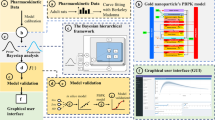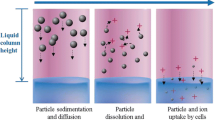Abstract
In this paper we demonstrate the validity of a mathematical chamber model to describe the absorption, distribution, and bioaccumulation of nonmetabolizable nanoparticles (NPs) using the example of silver NPs in the organism of laboratory rat. The model is constructed using experimental data on the bioaccumulation and biodistribution of silver NPs of average diameter of 35 ± 15 nm (M ± SD) radiolabeled with 110mAg. In the minimally acceptable form, the model includes all “chambers” in which NP level in the course of the experiment was no lower than 20–25% of its blood content, namely, the gastrointestinal tract (GIT), blood itself, osteomuscular carcass, liver, and spleen. NP bioaccumulation and biodistribution in these chambers is described by five independent linear differential equations of the 1st order. A numerical solution of this system of equations, with account for the data on timing of NP excretion from the GIT in the content of feces, makes it possible to determine the biokinetic rate constants for the interorgan transfer of NPs. These rate constants are used to establish the dose-dependence of the peak (maximum) and quasi-stationary NP content in critical target organs, respectively, in the case of acute (single) and subchronic (repeated) administration of NP in the gastrointestinal tract. The results justify the value of the method of mathematically modeling the interstitial transport and distribution of NPs to assess their potential toxic effects on a system level using previously obtained in vitro data and results from biokinetic studies.
Similar content being viewed by others
References
G. G. Onishchenko and V. A. Tutel’yan, “On toxicological researches, ways to estimate risks, to identify and determinate quantitavely nanomaterials,” Vopr. Pitan. 76 (6), 4–8 (2007).
G. G. Onishchenko, A. I. Archakov, V. V. Bessonov, B.G. Bokit’ko, A. L. Gintsburg, I. V. Gmoshinskii, A. I. Grigor’ev, N. F. Izmerov, M. P. Kirpichnikov, B. S. Naroditskii, V. I. Pokrovskii, A. I. Potapov, Yu. A. Rakhmanin, V. A. Tutel’yan, S. A. Khotimchenko, K. V. Shaitan, and S. A. Sheveleva, “Methodological approaches for estimating nanomaterials safety,” Gig. Sanit., No. 6, 3–10 (2007).
I. V. Gmoshinskii, V. V. Smirnova, and S. A. Khotimchenko, “Nanomaterials safety estimation: state of the art,” Ross. Nanotekhnol. 5 (9–10), 6–10 (2010).
P. J. Borm, D. Robbins, S. Haubold, T. Kuhlbusch, H. Fissan, K. Donaldson, R. Schins, V. Stone, W. Kreyling, J. Lademann, J. Krutmann, D. Warheit, and E. Oberdorster, “The potential risks of nanomaterials: a review carried out for ECETOC,” Part. Fibre Toxicol. 3 (11), 135 (2006).
G. Oberdörster, A. Maynard, K. Donaldson, V. Castranova, J. Fitzpatrick, K. Ausman, J. Carter, B. Karn, W. Kreyling, D. Lai, S. Olin, N. Monteiro-Riviere, D. Warheit, and H. Yang, “Principles for characterizing the potential human health effects from exposure to nanomaterials: elements of a screening strategy,” Part. Fibre Toxicol. 2 (1), 843 (2005).
G. Oberdörster, E. Oberdorster, and J. Oberdorster, “Nanotoxicology: an emerging discipline evolving from studies of ultrafine particles,” Environ. Health Perspect. 113, 823–839 (2005).
S. A. Khotimchenko, I. V. Gmoshinskii, and V. A. Tutel’yan, “The way to secure nanosized objects safety for human’s health,” Gig. Sanit., No. 5, 7–11 (2009).
V. M. Vernikov, I. V. Gmoshinskii, and S. A. Khotimchenko, “Ag nanoparticles in nature, industry, packaging materials for foodstuff: possible risks,” Vopr. Pitan. 78 (6), 13–20 (2009).
L. B. Piotrovskii and O. I. Kiselev, Fullerens in Biology (St. Petersburg, 2006) [in Russian].
J. M. Balbus, A. D. Maynard, V. L. Colvin, V. Castranova, G. P. Daston, R. A. Denison, K. L. Dreher, P. L. Goering, A. M. Goldberg, K. M. Kulinowski, N. A. Monteiro-Riviere, G. Oberdörster, G. S. Omenn, K. E. Pinkerton, K. S. Ramos, K. M. Rest, J. B. Sass, E. K. Silbergeld, and B. A. Wong, “Meeting report: hazard assessment for nanoparticles — report from an interdisciplinary workshop,” Environ. Health Perspect. 115 (11), 1654–1659 (2007).
G. Oberdorster, E. Oberdorster, and J. Oberdorster, “Nanotoxicology: an emerging discipline evolving from studies of ultrafine particles,” Environ. Health Perspect. 113, 823–839 (2005).
Yu. P. Buzulukov, I. V. Gmoshinskii, R. V. Raspopov, V. F. Demin, V. Yu. Solov’ev, P. G. Kuz’min, G. A. Shafeev, and S. A. Khotimchenko, Med. Radiol. Radiats. Bezopasn. 57 (3), 5–12 (2012).
R. V. Raspopov, Yu. P. Buzulukov, N. S. Marchenkov, V. Yu. Solov’ev, V. F. Demin, V. S. Kalistratova, I. V. Gmoshinskii, and S. A. Khotimchenko, “Zn oxide nanoparticles bioaccessibility. The way to research by means of radioactive indicators,” Vopr. Pitan. 79 (6), 14–18 (2010).
E. A. Melnik, Yu. P. Buzulukov, V. F. Demin, V. A. Demin, I. V. Gmoshinski, N. V. Tyshko, and V. A. Tutelyan, “Transfer of silver nanoparticles through the placenta and breast milk during in vivo experiments on rats,” Acta Natur. 5 (3(18)), 48–56 (2013).
Yu. P. Buzulukov, E. A. Arianova, V. F. Demin, I. V. Safenkova, I. V. Gmoshinski, and V. A. Tutelyan, “Bioaccumulation of silver and gold nanoparticles in organs and tissues of rats studied by neutron activation analysis,” Biol. Bull. 41 (3), 255–263 (2014).
K. Pinna, L. R. Woodhouse, B. Sutherland, D. M. Shames, and J. C. King, “Exchangeable zinc pool masses and tuirnover are maintained in healthy man with low zinc intakes,” J. Nutr. 131 (9), 2288–2294 (2001).
M. Janghorbani, R. F. Martin, L. J. Kasper, X. F. Sun, and V. R. Young, “The selenite-exchangeable pool in humans: a new concept for the assessment of selenium status,” Am. J. Clin. Nutr. 51 (4), 670–677 (1990).
I. V. Gmoshinskii, T. Yu. Verina, V. K. Mazo, and I. A. Morozov, “Gastrointestinal tract barrier permeability for polyethylene glycol-4000 macromolecules: the way to estimate mechanism and repeatability,” Byull. Eksperim. Biol. Med. 114 (11), 532–534 (1992).
S. M. Hussain, K. L. Hess, J. M. Gearhart, K. T. Geiss, and J. J. Schlager, “In vitro toxicity of nanoparticles in BRL 3A rat liver cells,” Toxicol. in vitro 9 (7), 975–983 (2005).
L. Braydich-Stolle, S. Hussain, J. J. Schlager, and M. C. Hofmann, “In vitro cytotoxicity of nanoparticles in mammalian germline stem cells,” Toxicol. Sci. 88 (2), 412–419 (2005).
S. Arora, J. Jain, J. M. Rajwade, and K. M. Paknikar, “Interactions of silver nanoparticles with primary mouse fibroblasts and liver cells,” Toxicol. Appl. Pharmacol. 236 (3), 310–318 (2009).
Z. Liu, G. Ren, T. Zhang, and Z. Yang, “Action potential changes associated with the inhibitory effects on voltage-gated sodium current of hippocampal CA1 neurons by silver nanoparticles,” Toxicology 264 (3), 179–184 (2009).
S. H. Shin, M. K. Ye, H. S. Kim, and H. S. Kang, “The effects of nanosilver on the proliferation and cytokine expression by peripheral blood mononuclear cells,” Int. Immunopharmacol. 7 (13), 1813–1818 (2007).
C. M. Powers, A. R. Badireddy, I. T. Ryde, F. J. Seidler, and T. A. Slotkin, “Silver nanoparticles compromise neurodevelopment in PC12 cells: critical contributions of silver ion, particle size, coating, and composition,” Environ. Health Perspect. 119 (1), 37–44 (2011).
A. Haase, S. Rott, A. Mantion, P. Graf, J. Plendl, A. F. Thünemann, W. P. Meier, A. Taubert, A. Luch, and G. Reiser, “Effects of silver nanoparticles on primary mixed neural cell cultures: uptake, oxidative stress and acute calcium responses,” Toxicol. Sci. 126 (2), 457–468 (2012).
A. A. Shumakova, V. V. Smirnova, O. N. Tananova, E. N. Trushina, L. V. Kravchenko, I. V. Aksenov, A. V. Selifanov, Kh. S. Soto, G. G. Kuznetsova, A. V. Bulakhov, I. V. Safenkova, I. V. Gmoshinskii, and S. A. Khotimchenko, “Toxicological hygienic characteristics of Ag nanoparticles introduces into rat gastrointestinal tract,” Vopr. Pitan. 80 (6), 9–18 (2011).
Y. S. Kim, M. Y. Song, J. D. Park, K. S. Song, H.R. Ryu, Y. H. Chung, H. K. Chang, J. H. Lee, K. H. Oh, B. J. Kelman, I. K. Hwang, and I. J. Je Yu, “Subchronic oral toxicity of silver nanoparticles,” Part. Fibre Toxicol. 7 (1), 20 (2010).
K. C. Bhol and P. J. Schechter, “Effects of nanocrystalline silver (NPI 32101) in a rat model of ulcerative colitis,” Dig. Dis. Sci. 52 (10), 2732–2742 (2007).
E. Sawosz, M. Binek, M. Grodzik, M. Zielinska, P. Sysa, M. Szmidt, T. Niemiec, and A. Chwalibog, “Influence of hydrocolloidal silver nanoparticles on gastrointestinal microflora and morphology of enterocytes of quails,” Arch. Anim. Nutr. 61 (6), 444–451 (2007).
K. Loeschner, N. Hadrup, K. Qvortrup, A. Larsen, X.Gao,_U. Vogel, A. Mortensen, H. R. Lam, and E. H. Larsen, “Distribution of silver in rats following 28 days of repeated oral exposure to silver nanoparticles or silver actate,” Part. Fibre Toxicol. 8, 18 (2011).
T. A. Platonova, S. M. Pridvorova, A. V. Zherdev, L. S. Vasilevskaya, E. A. Arianova, I. V. Gmoshinskii, S. A. Khotimchenko, B. B. Dzantiev, V. O. Popov, and V. A. Tutel’yan, “The way to identify Ag nanoparticles in tissues of rat mucous membrane of the small intestine, of liver and spleen by means of transmission electronic microscopy,” Byul. Eksperim. Biol. Med. 155 (2), 204–209 (2013).
M. Van der Zande, R. J. Vanderbriel, E. Van Doren, E. Kramer, Z. Herrera Rivera, C. S. Serano-Rojero, E. R. Gremmer, J. Mast, R. J. Peters, P. C. Hollman, P. J. Hendriksen, H. J. Marvin, A. A. Peijnenburg, and H. Bouwmeester, “Distribution, elimination and toxicity of silver nanoparticles and silver ions in rats after 28-day exposure,” ACS Nano 6 (8), 7427–7442 (2012).
M. Semmler, J. Seitz, and F. Erbe, “Long-term clearance kinetics of inhaled ultrafine insoluble iridium particles from the rat lung, including transient translocation into secondary organs,” Inhal. Toxicol. 16 (6–7), 453–459 (2004).
J. Pelka, H. Gehrke, and M. Esselen, “Cellular uptake of platinum nanoparticles in human colon carcinoma cells and their impact on cellular redox systems and DNA integrity,” Chem. Res. Toxicol. 22 (4), 649–659 (2009).
Author information
Authors and Affiliations
Corresponding author
Rights and permissions
About this article
Cite this article
Demin, V.A., Gmoshinsky, I.V., Demin, V.F. et al. Modeling interorgan distribution and bioaccumulation of engineered nanoparticles (using the example of silver nanoparticles). Nanotechnol Russia 10, 288–296 (2015). https://doi.org/10.1134/S1995078015020081
Received:
Accepted:
Published:
Issue Date:
DOI: https://doi.org/10.1134/S1995078015020081




